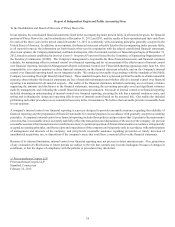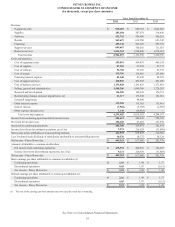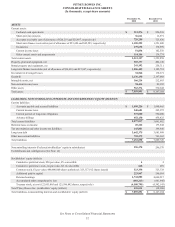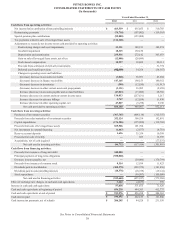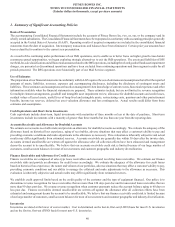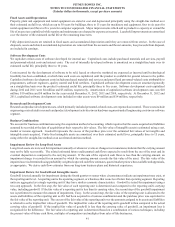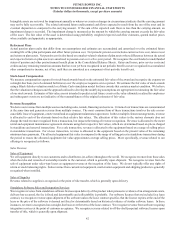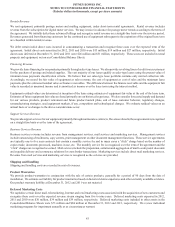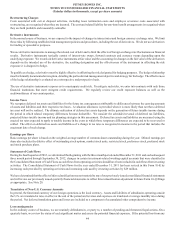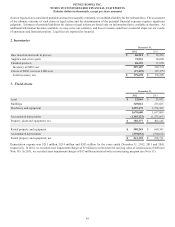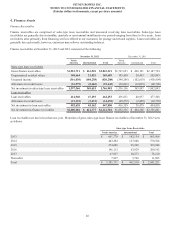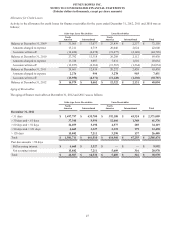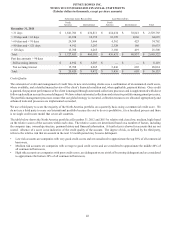Pitney Bowes 2012 Annual Report Download - page 60
Download and view the complete annual report
Please find page 60 of the 2012 Pitney Bowes annual report below. You can navigate through the pages in the report by either clicking on the pages listed below, or by using the keyword search tool below to find specific information within the annual report.
PITNEY BOWES INC.
NOTES TO CONSOLIDATED FINANCIAL STATEMENTS
(Tabular dollars in thousands, except per share amounts)
42
Intangible assets are reviewed for impairment annually or whenever events or changes in circumstances indicate that the carrying amount
may not be fully recoverable. The related estimated future undiscounted cash flows expected to result from the use of the asset and its
eventual disposition is compared to the carrying amount. If the sum of the expected cash flows is less than the carrying amount, an
impairment charge is recorded. The impairment charge is measured as the amount by which the carrying amount exceeds the fair value
of the asset. The fair value of the asset is determined using probability weighted expected cash flow estimates, quoted market prices
when available and appraisals, as appropriate.
Retirement Plans
Actual pension plan results that differ from our assumptions and estimates are accumulated and amortized over the estimated future
working life of the plan participants and affect future pension cost. Net periodic pension cost includes current service cost, interest cost
and return on plan assets. Net pension cost is also based on a market-related valuation of plan assets where differences between the actual
and expected return on plan assets are amortized to pension cost over a five-year period. We recognize the overfunded or underfunded
status of pension and other postretirement benefit plans in the Consolidated Balance Sheets. Gains and losses, prior service costs and
credits and any remaining transition amounts that have not yet been recognized in net periodic benefit cost are recognized in accumulated
other comprehensive income, net of tax, until they are amortized as a component of net periodic benefit cost.
Stock-based Compensation
We measure compensation expense for stock-based awards based on the estimated fair value of the award and recognize the expense on
a straight-line basis (net of estimated forfeitures) over the employee requisite service period. We estimate the fair value of stock awards
using a Black-Scholes valuation model or a Monte Carlo simulation model for those awards that contain a market condition. We believe
that the valuation techniques and the approach utilized to develop the underlying assumptions are appropriate in estimating the fair value
of our stock awards. Estimates of fair value are not intended to predict actual future events or the value ultimately realized by employees
and subsequent events are not indicative of the reasonableness of the original estimates of fair value.
Revenue Recognition
We derive our revenue from multiple sources including sales, rentals, financing and services. Certain of our transactions are consummated
at the same time and generate revenue from multiple sources. The most common form of these transactions involves the sale or non-
cancelable lease of equipment, a meter rental and an equipment maintenance agreement. In these multiple element arrangements, revenue
is allocated to each of the elements based on their relative fair values. The allocation of fair values to the various elements does not
change the total revenue recognized from a transaction, but impacts the timing of revenue recognition. Revenue is allocated to the meter
rental and equipment maintenance agreement elements using their respective fair values, which are determined based on prices charged
in standalone and renewal transactions. For a sale transaction, revenue is allocated to the equipment based on a range of selling prices
in standalone transactions. For a lease transaction, revenue is allocated to the equipment based on the present value of the remaining
minimum lease payments. The allocated equipment fair value is compared to the range of selling prices in standalone transactions during
the period to ensure the allocated equipment fair value approximates average selling prices. More specifically, revenue related to our
offerings is recognized as follows:
Sales Revenue
Sales of Equipment
We sell equipment directly to our customers and to distributors (re-sellers) throughout the world. We recognize revenue from these sales
when the risks and rewards of ownership transfer to the customer, which is generally upon shipment. We recognize revenue from the
sale of equipment under sales-type leases as equipment revenue at the inception of the lease. We do not typically offer any rights of
return or stock balancing rights. Sales revenue from customized equipment, mail creation equipment and shipping products is generally
recognized when installed.
Sales of Supplies
Revenue related to supplies is recognized at the point of title transfer, which is generally upon delivery.
Standalone Software Sales and Integration Services
We recognize revenue from standalone software licenses upon delivery of the product when persuasive evidence of an arrangement exists,
delivery has occurred, the fee is fixed and determinable and collectability is probable. For software licenses that are included in a lease
contract, we recognize revenue upon shipment of the software unless the lease contract specifies that the license expires at the end of the
lease or the price of the software is deemed not fixed or determinable based on historical evidence of similar software leases. In these
instances, revenue is recognized on a straight-line basis over the term of the lease contract. We recognize revenue from software requiring
integration services at the point of customer acceptance. We recognize revenue related to off-the-shelf perpetual software licenses upon
transfer of title, which is generally upon shipment.




